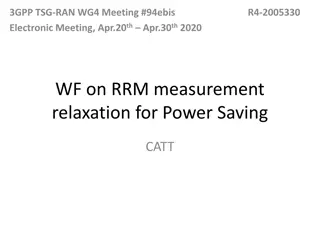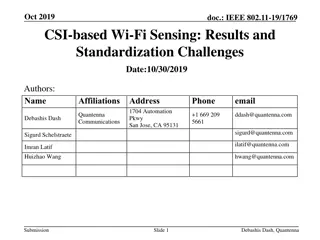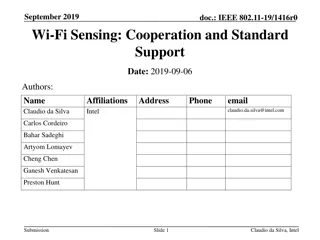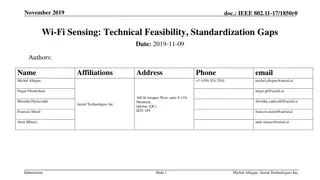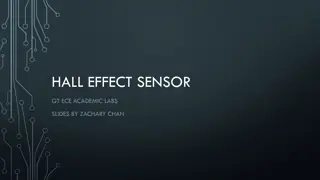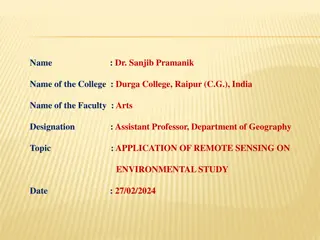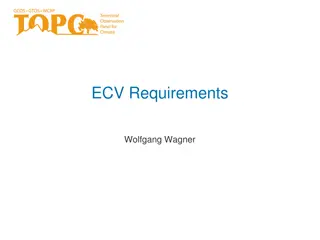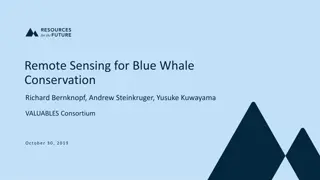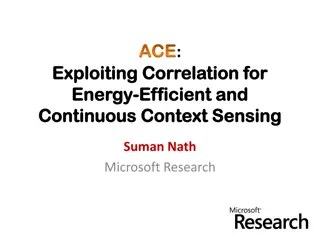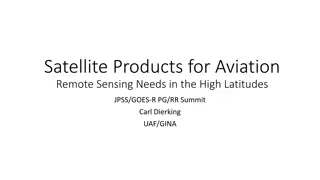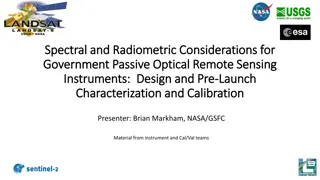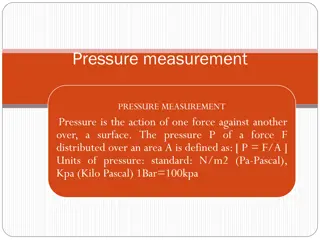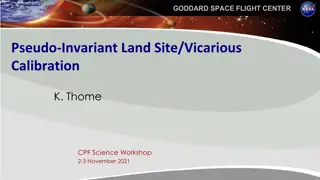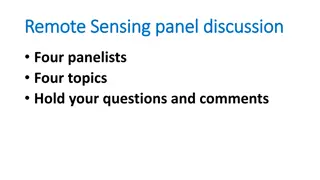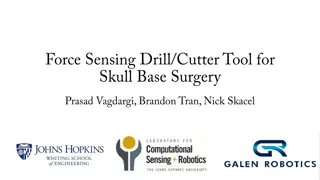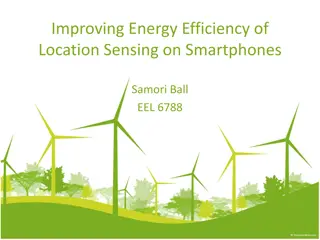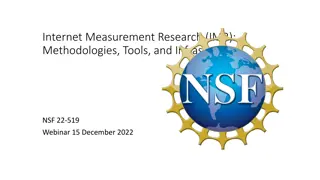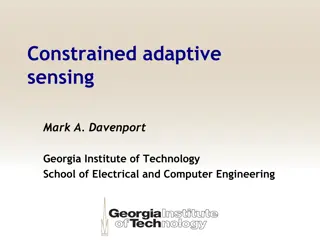Understanding Remote Sensing Sensor Resolutions & Colour Composite
Explore the art and science of remote sensing, detailing sensor types, resolution categories, and color composite techniques. Learn about the stages involved in remote sensing, sensor variations, and band designations for satellites like Landsat 8. Discover the significance of pixel, high-resolution
6 views • 13 slides
Understanding Measurement Scales and Scaling Techniques
Measurement scales play a crucial role in marketing research, with techniques like scaling helping to categorize data. The content discusses four types of measurement scales: nominal, ordinal, interval, and ratio, outlining their characteristics and differences. Scaling techniques involve placing re
5 views • 7 slides
Latest Consensus on UWB Sensing for 802.15.4ab
Co-authors from various companies present the latest agreement on ultra-wideband (UWB) sensing topics for the IEEE 802.15.4ab standard. The consensus includes definitions for sensing pulse shape, packet formats for bi/multi-static sensing, and support for specific sequences and patterns in UWB sensi
1 views • 27 slides
RRM Measurement Relaxation for UE Power Saving in 3GPP Meeting #94ebis
This document discusses methods for relaxing RRM measurements to save power in UE devices during idle/inactive states. It covers scenarios with low mobility, non-cell edge, and combinations, suggesting options like longer measurement intervals and relaxing neighbor cell measurement requirements. The
0 views • 7 slides
Spectrum Sensing for Enhanced Channel Access in Wireless Networks
This document presents a proposal for Spectrum Sensing Based Deferral (SSBD) to improve channel access in wireless networks. SSBD incorporates spectrum sensing with transmission deferral in a time-bound manner to enhance performance, reliability, and latency control. The proposed solution safeguards
1 views • 11 slides
Understanding Motion and Measurement of Distances in Science at Sainik School Gopalganj
Explore the concepts of motion and measurement of distances in science as taught by Dr. A.K. Choubey at Sainik School Gopalganj. Discover the development of means of transport, different measurement methods like non-standard and standard measures, the significance of measurement, and the Internation
1 views • 16 slides
IEEE 802.11-21/1321r1 WLAN Sensing Procedure Proposal
This document by Solomon Trainin from Qualcomm presents a proposal on aligning the SFD for the WLAN sensing procedure. It aims to resolve contradictions, optimize behavior, and introduce a structured WLAN sensing procedure. The content outlines phases, terminology, setup, measurement, and reporting
0 views • 8 slides
IEEE 802.11-21/2011r0 Sensing NDP Announcement Overview
This document presents an overview of the IEEE 802.11-21/2011r0 Sensing NDP Announcement for utilizing NDP in sensing applications. It discusses the motivation behind NDP sensing, outlines the NDP Announcement frames, and explains possible sensing frame exchange sequences. The Ranging NDP Announceme
0 views • 8 slides
IEEE 802.11-19/1769: CSI-based Wi-Fi Sensing Results & Challenges
This document from Oct. 2019 explores IEEE 802.11-19/1769 CSI-based Wi-Fi sensing, focusing on results and standardization challenges. It delves into the concept of Wi-Fi sensing, its applications in security, automation, healthcare, and more, as well as the importance of CSI parameters such as reso
0 views • 10 slides
Wi-Fi Sensing in IoT: Advantages, Use Cases, and Challenges
Wi-Fi sensing utilizes Wi-Fi devices/network to detect presence, range, angle, and velocity of passive/non-transceiver objects. This document discusses the definition, advantages, use cases like smart home applications, and challenges of Wi-Fi sensing compared to other sensing technologies. It also
6 views • 15 slides
Exploring Wi-Fi Sensing for Motion Detection and Beyond
The document discusses the utilization of Wi-Fi signals for sensing various features in a given environment, such as motion, presence, gesture, and more, without assuming the subject carries a Wi-Fi device. It covers applications, technical principles, and a three-phase algorithm for motion detectio
0 views • 24 slides
Wireless Sensing Privacy Discussions in May 2023 Document
May 2023 document (.IEEE 802..11-23-0782-00-00bf) discusses privacy issues related to wireless sensing, including unauthorized access to sensing reports, tracking of sensing devices, and potential eavesdropping on sensing signals. It proposes solutions to protect sensitive information and addresses
4 views • 12 slides
Functional Measurement Systems Analysis for Curve Data Using Random Effects Models
Measurement Systems Analysis (MSA) is crucial in determining the contribution of measurement variation to overall process variation. When dealing with curve data instead of single points, a Functional MSA approach using random effects models can be applied. This involves estimating mean curves, mode
0 views • 5 slides
Comparison of Trigger-based vs. Non-Trigger-based Sensing Measurement in IEEE 802.11
The document discusses the differences between Trigger-based (TB) and Non-Trigger-based (Non-TB) sensing measurement instances in IEEE 802.11 standards, focusing on who initiates the sensing measurement. TB sensing is initiated by the AP, while Non-TB sensing is initiated by a non-AP STA, enabling o
6 views • 13 slides
IEEE P802.15 WPAN Sensing Device Submission
This submission to the IEEE P802.15 Working Group focuses on the development of a sensing device for Wireless Personal Area Networks (WPANs). The document discusses the integration of Ultra-Wideband (UWB) technology for sensing applications, including presence detection and environment mapping. Key
0 views • 16 slides
Exploring Wi-Fi Sensing: Feasibility and Standardization Gaps
Delve into the technical aspects of Wi-Fi sensing, discussing its definition, feasibility, and standardization gaps according to the IEEE 802.11 standard. The presentation highlights the ability of Wi-Fi systems to detect environmental changes and explores scientific publications related to Wi-Fi se
0 views • 27 slides
Wireless LAN Sensing Use Cases in Home Environments
The document discusses use cases for Wireless LAN (WLAN) sensing in home environments, focusing on the connection between multiple access points and home appliances for enhanced performance. It outlines scenarios such as gesture-controlled home appliance operation, user identification for personaliz
0 views • 11 slides
IEEE 802.11-21/0391r0: Minimizing Impact in WLAN Sensing Design
The document presents discussions on minimizing impact as a design goal within the IEEE 802.11-21/0391r0 context, emphasizing the efficiency related to the impact of sensing on network performance. It addresses the current status, constraints, design options, and thoughts regarding WLAN sensing with
1 views • 8 slides
IEEE 802.11-22/2065r2 Timestamp Discussion
In the December 2022 IEEE document, Chris Beg of Cognitive Systems discusses the need for measurement timestamping at the receiver vs. transmitter for signal measurement applications like WLAN sensing and Doppler estimation. The document outlines the importance of timestamp placement for accurate me
2 views • 16 slides
Exploring Measurement Challenges and Concepts in Grade Five Mathematics
Delve into a variety of measurement challenges in Grade Five mathematics, including different units, common errors, measurement components, big ideas, accuracy, precision, and the measurement process. Understand the nuances between accuracy and precision, factors affecting measurement accuracy, and
0 views • 39 slides
Remote Sensing Methods for Identifying Degraded Forests in the Amazon
Using multisource remote sensing data, this study aims to identify and characterize forest degradation in the Amazonian landscape. Field work in Paragominas, Brazil, combined with optical and radar data analysis, helps in understanding carbon stocks and typology of degraded forests. The research foc
3 views • 7 slides
Understanding Hall Effect Sensors in Electronic Labs
Hall Effect sensors play a crucial role in detecting magnetic fields, enabling applications such as current sensing, rotational speed measurement in motors, and magnetic proximity sensing. They operate based on the Hall Effect phenomenon, where a magnetic field influences the flow of current in a se
2 views • 5 slides
Sparse Millimeter-Wave Imaging Using Compressed Sensing and Point Spread Function Calibration
A novel indoor millimeter-wave imaging system based on sparsity estimated compressed sensing and calibrated point spread function is introduced. The system utilizes a unique calibration procedure to process the point spread function acquired from measuring a suspended point scatterer. By estimating
2 views • 26 slides
Exploring Applications of Remote Sensing in Environmental Studies
Dr. Sanjib Pramanik, an Assistant Professor at Durga College, delves into the fascinating realm of remote sensing for environmental studies. Remote sensing allows data collection from a distance, utilizing methods like air photos and satellite imagery. The environment comprises components such as na
0 views • 35 slides
Advanced Remote Sensing Requirements and Terminology in Environmental Monitoring
Explore the latest satellite data requirements and terminology for environmental monitoring, focusing on surface soil moisture measurement, three-level climate application approach, and on-site validation reports. Gain insights into maximizing the accuracy and stability of remote sensing data for im
0 views • 6 slides
Advances in Remote Sensing for Soil Moisture Validation and Calibration
Cutting-edge methods like Cosmic-Ray Neutron Sensing (CRNS) and mobile measurements are revolutionizing soil moisture validation and calibration. From satellite-based techniques to local approaches, researchers are enhancing the accuracy and reliability of soil moisture data for various applications
1 views • 15 slides
UE PRS Measurement Requirements Discussion at 3GPP TSG-RAN WG4 Meeting #98-e
Discussion at the 3GPP TSG-RAN WG4 Meeting #98-e focused on UE PRS measurement requirements. The topics included consideration of muting in measurement periods, periodicity scaling for PRS resources, handling different resource periodicities, and offsets in measurement periods. Various options were
0 views • 18 slides
Remote Sensing for Blue Whale Conservation: Enhancing Maritime Policy
Using remote sensing technology to monitor blue whale habitats can help address the conservation challenges posed by ship strikes. By predicting species distributions with greater precision, regulatory agencies can implement effective measures to reduce the risks faced by blue whales. Remote sensing
0 views • 18 slides
Efficient Context Sensing for Mobile Applications
Leveraging correlations between different user contexts, the ACEACE framework by Suman Nath explores energy-efficient continuous context sensing for mobile apps. By inferring expensive attributes from cheaper ones, the system optimizes sensing tasks based on human activities, significantly reducing
0 views • 23 slides
Satellite Products for Aviation Remote Sensing Needs in High Latitudes
Addressing the specific needs of aviation remote sensing in high latitudes, this content explores the importance of satellite products, variations in equipment requirements, data expectations, and the significance of cloud products for aviation safety. Feedback from aircraft operators emphasizes the
0 views • 8 slides
Understanding Accounting Research Methods: Measurement and Sampling
Measurement is a crucial aspect of research in accounting. It involves assigning numbers to empirical events, objects, or properties. Measurement consists of selecting measurable phenomena, developing mapping rules, and applying these rules appropriately. The process of measurement includes determin
0 views • 63 slides
Spectral and Radiometric Considerations for Government Remote Sensing Instruments
This presentation explores the important considerations in designing and calibrating government passive optical remote sensing instruments, focusing on spectral and radiometric aspects. Topics include spectral variation, design considerations, uniformity, reflectance calibration, and examples from i
0 views • 27 slides
Understanding Pressure Measurement Techniques
Pressure measurement involves the action of force over a surface. Various sensing elements such as Bourdon tubes, diaphragms, and bellows are utilized for measuring pressure. Bellows sensors are flexible cylindrical enclosures, while Bourdon gauges use coiled tubes for pressure measurement. Differen
0 views • 11 slides
Radiometric Calibration Methods for Remote Sensing Applications
Techniques for radiometric calibration in remote sensing include vicarious approaches utilizing invariant desert sites, in-situ methods characterizing surfaces and atmospheres, and SI-traceable measurements for intercomparisons between sensors. The repeatability of in-situ results and comparison wit
0 views • 20 slides
Remote Sensing Panel Discussion: Addressing Challenges in RFI Reporting, Regulations, and Protection of Operations
The Remote Sensing panel discussion highlights key issues such as the lack of RFI reporting to the ITU, importance of RFI reporting for regulatory enforcement, obstacles in protecting remote sensing operations, desired changes in Radio Regulations, and potential discussion points for the research an
0 views • 7 slides
Enhancing Robot Control in Neurosurgery through Force Sensing Integration
The project aims to improve the cooperative control of the Galen robot in neurosurgery by measuring and integrating tool-to-tissue forces. By sensing these forces, the system can enhance visual feedback, establish safety limits, evaluate surgical skills, and allow unbiased comparisons of techniques.
0 views • 12 slides
Enhancing Smartphone Location Sensing Efficiency
This study delves into optimizing energy consumption in smartphone location sensing mechanisms like GPS and Network Based Triangulation. Comparisons of battery drainage rates with and without GPS provide insights. Additionally, the energy efficiency of Network Based Triangulation as a less accurate
1 views • 41 slides
Cognitive Radio Network and Game Theory Exploration at University of Houston
Explore the application of cooperative game theory in cognitive radio networks, focusing on spectrum sensing, dynamic spectrum access, and coalitional games. Detailed overview of research conducted at the Department of Electrical and Computer Engineering, University of Houston. Learn about cognitive
0 views • 42 slides
Advancing Internet Measurement Research: IMR Program Overview
The Internet Measurement Research (IMR) program aims to enhance Internet measurement methodologies, tools, and infrastructure for a comprehensive understanding of wired and wireless networks. It promotes the development of new data collection methods, measurement tools, and related infrastructure. T
1 views • 23 slides
Constrained Adaptive Sensing and Benefits of Adaptivity
Constrained adaptive sensing involves estimating sparse signals with constraints, utilizing strategies like nonadaptive sensing and adaptive sensing. Benefits of adaptivity include reducing errors and improving estimation accuracy in signal processing. It explores the potential for improvement in re
0 views • 17 slides



